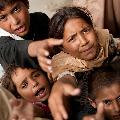
More than one hundred thousand children left homeless by Pakistan’s floods are in danger of dying because they simply do not have enough to eat, according to UNICEF.
“You are seeing children who were probably very close to the brink of being malnourished, and the emergency has just pushed them over the edge. There is just not the capacity to treat this level of severe acute malnutrition”, said Erin Boyd, a UNICEF emergency nutritionist working in southern Pakistan.
Children from poor rural areas, already weak from living on too little food before the floods, are fighting to stay alive as diarrhea, respiratory diseases and malaria attack their emaciated bodies. The floods have affected more than 20 million people, nearly half of whom have lost their homes, and many have been herded into crude, crowded camps or left to fend for themselves along roads. But doctors warn the real catastrophe is moving much slower than the murky waters.
In the government-run Railway Hospital in Sukkur Sindh province, one ward has already been converted into a patient-feeding centre. Some babies, a fraction of their normal weight, wail and gasp on diarrhea-stained sheets while others wince quietly as if trying to find the strength to cry. Some have sunken cheeks, others have hollow eyes or bottoms that are merely bones covered by folds of scaly, wrinkled skin.
Their mothers sit on the beds beside them, spoon-feeding milk and pinches of ‘plumpy nut’, a sweet peanut butter-based nutritional paste dubbed chocolate by doctors. Many of the women are unable to produce breast milk because they are too weak and ill themselves.
The situation in the camps is even worse – the temperature is 38 degrees and the camp reeks of urine and animal manure. Lack of clean drinking water and the high temperatures are causing skin and eye infections and illnesses to sweep through them, with children most at risk.
Many mothers told us that their children are traumatised and scared. This is confirmed by doctors who say that they are seeing a lot of children who are in shock, where it is difficult to take a pulse reading, attach a drip or get them to explain what is wrong. In this situation it is very clear that women and children are suffering the most. You can hear hundreds of horrifying stories of misery, suffering, hunger and poverty from these women and children.
Mothers are forced to watch helplessly as their children lie dying from starvation and illness. Suhani Bunglani is living in a relief camp with two children. Her newborn girl has already died and her remaining two baby girls are awaiting the same fate – aged one and two, they are slowly starving, with arms and legs as fragile as twigs. Doctors have warned Bunglani three times to take her children to the hospital or they will die. The mother says she knows they need help, but she cannot leave the tent without her husband’s consent. She must stay until he returns, even if it means risking her daughters’ lives.
Another woman, Jannan Soorjo, summoned the energy to give birth in a graveyard that has become her refuge from the floods. But she cannot produce the milk to feed her baby, she looks down helplessly at her crying son because she has not eaten enough to produce food for him: “I have not been able to suckle him since he was born. We have nothing else to feed him to stop him crying.” Her husband Ahmad Soorjo, a farm labourer, says: “With two cows, three goats and plenty of grain to eat at home, we felt relatively comfortable. Every man among the 100 families in the village had a job to do, a home to live in and a family to head. Now we are all beggars. I tried to find a job but failed. What shall we do? I cannot beg.”
Missing children
International aid agencies carrying out relief activities in flood-hit areas of Pakistan also fear that hundreds of children have become separated from their parents. The floods devastated huge areas, forcing local populations to leave behind all their belongings as they fled to safety. Many affected families have reported their children missing; many do not know whether they are alive or dead.
Pregnant women at risk
The United Nations Population Fund (UNFPA) has warned that thousands of pregnant women displaced by the floods face increased risks of death and disability unless relief efforts are stepped up to meet their needs. They estimate that there are 500,000 pregnant women in the flood-affected areas – every day around 1,700 of them go into labour and more than 250 will experience complications requiring life-saving medical intervention. Yet most of those displaced in the crisis still lack access to basic health services, let alone skilled delivery assistance. Maternal mortality is high in Pakistan in normal times, as 500 women die for every 100,000 live births; now trauma, malnutrition and poor hygiene make the flood victims more vulnerable.
Health officials fear that the thousands of babies who will be born in the country’s flood-affected areas over the next six months are at severe risk of malnourishment because of the scarcity of food. The floods have so far claimed at least 147 lives in Sindh, mostly women and children who fell ill because of the unhygienic living conditions or from waterborne diseases. There is no government action to provide adequate healthcare facilities in the camps – the situation is extremely critical, but health authorities are not taking it seriously.

Be the first to comment